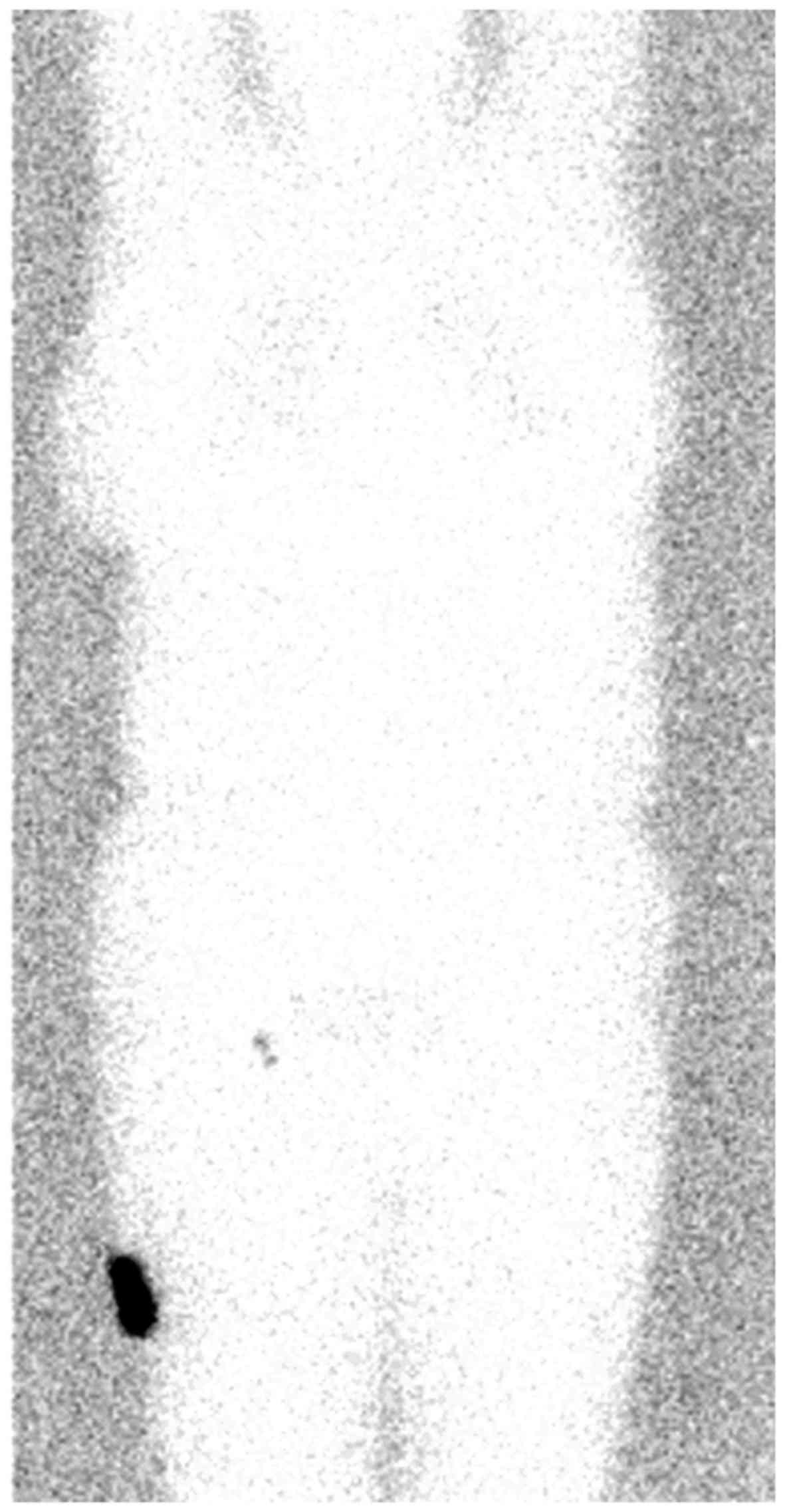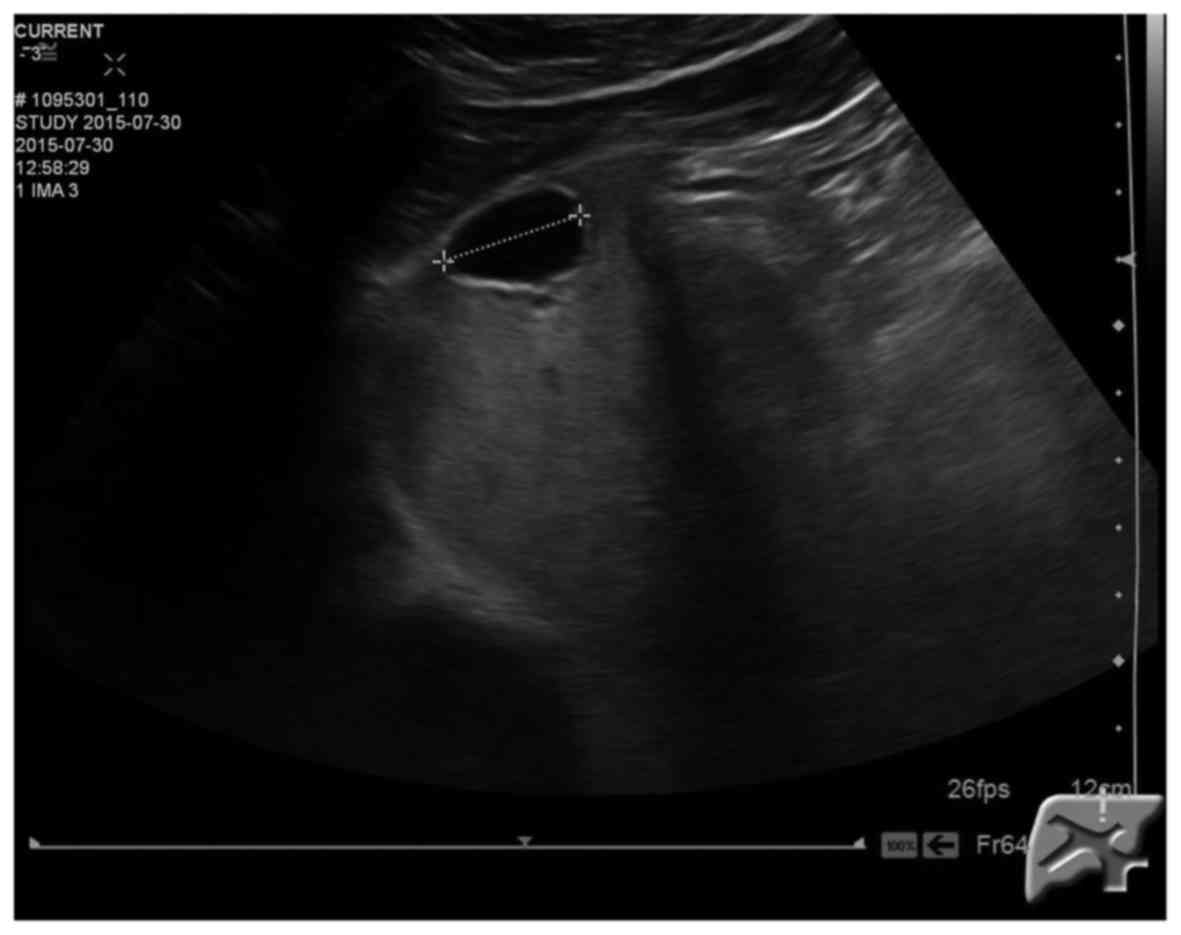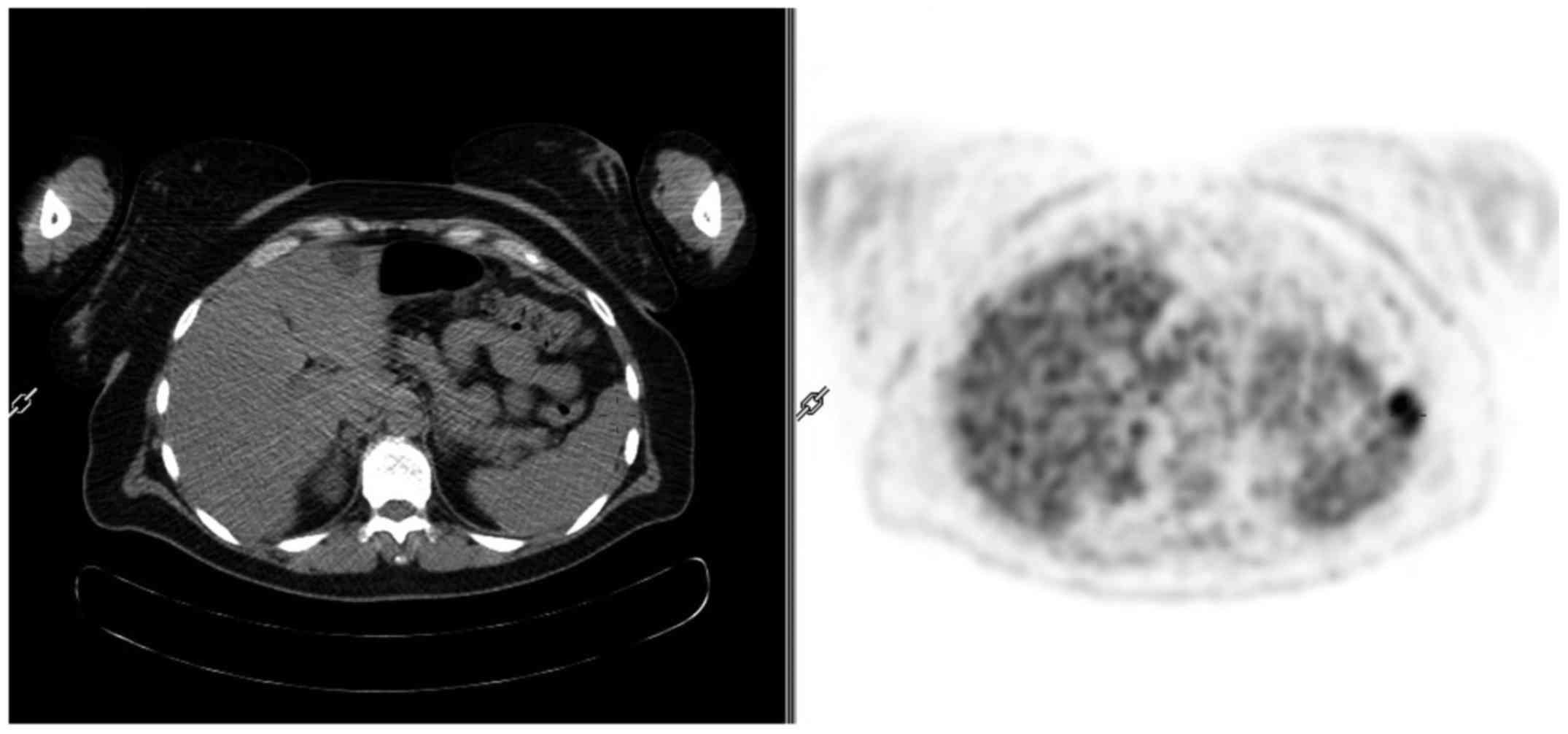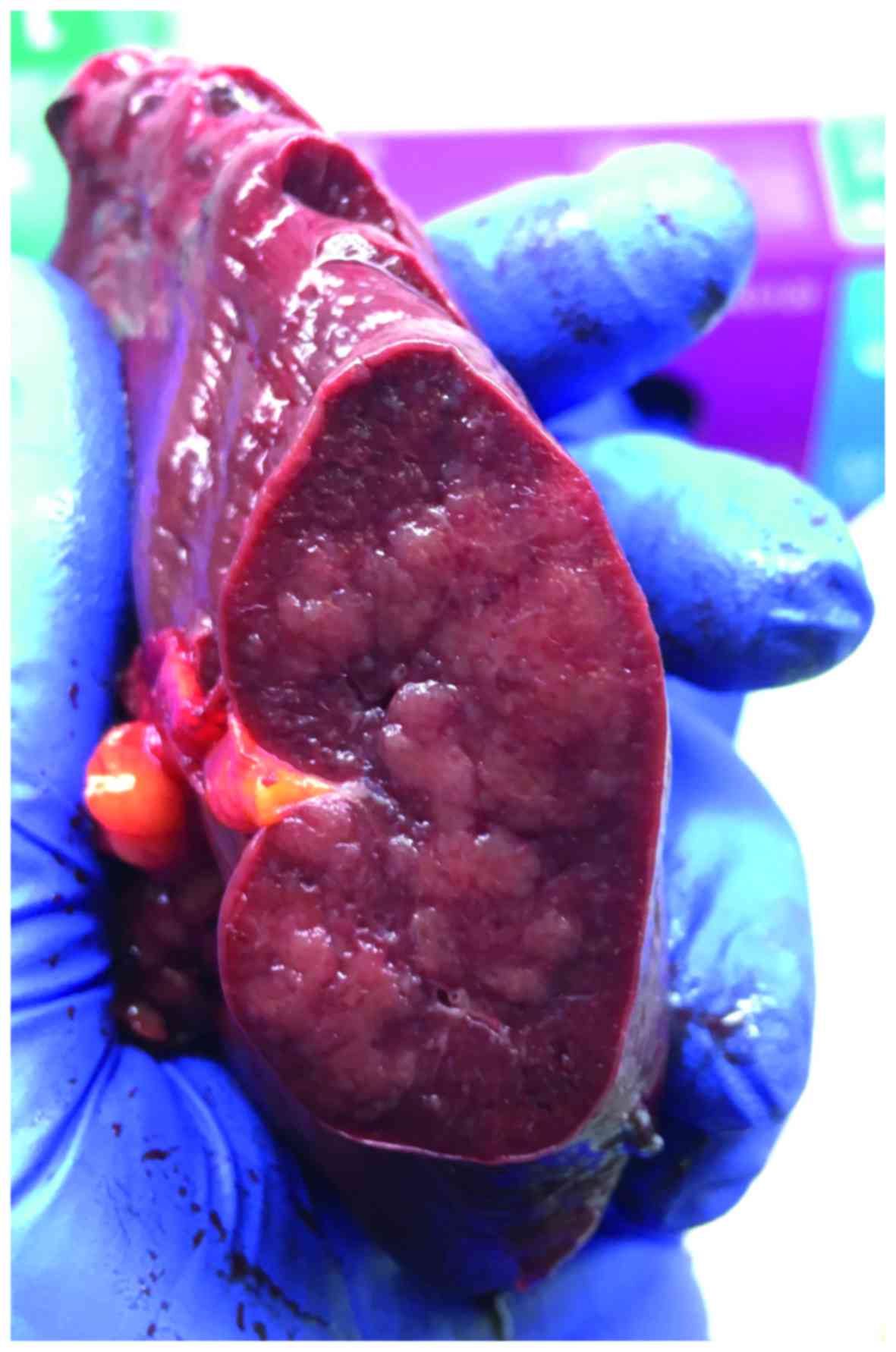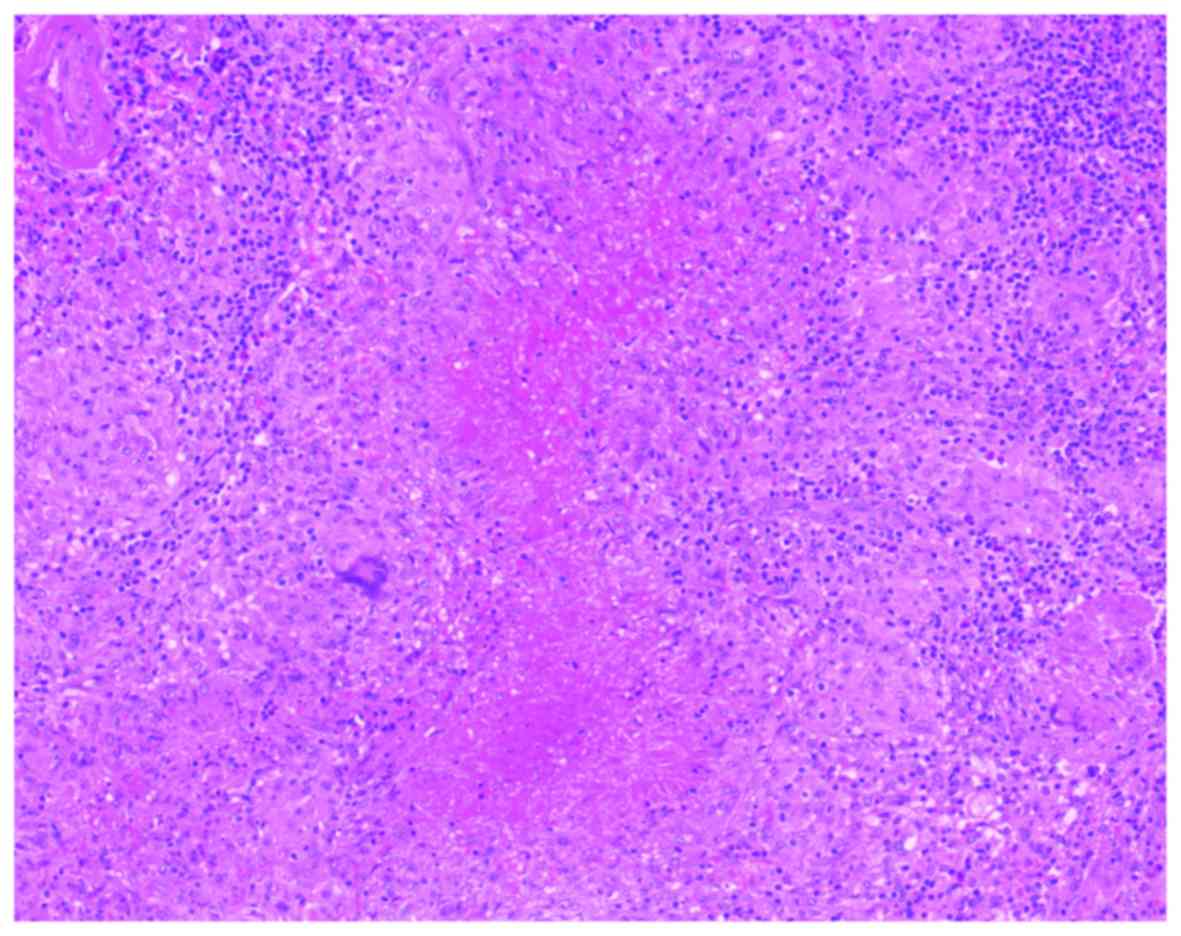Atypical spleen tuberculosis in a melanoma patient accidentally detected during a 18F‑FDG PET/CT study: Case report
- Authors:
- Published online on: November 13, 2017 https://doi.org/10.3892/mco.2017.1498
- Pages: 89-92
Abstract
Introduction
Nuclear medicine techniques have shown some advantages over conventional imaging methods such as X-ray, CT, MRI, because they illustrate functional changes in a patient which occur before anatomic changes visualized by conventional imaging methods. The introduction of PET/CT has brought a new quality in the field of diagnostic tests. It had a significant impact on the treatment of cancer patients and gives a better insight into the nature of cancer (1). Whole body PET/CT scan can immediately detect or is likely to exclude or confirm distant metastases. Metastases are detected at ~11% of patients with normal CT and in 41% the result of the PET/CT forces to change their behavior and upstage cancer patients. In addition, PET/CT can solve the problems that give inconclusive results of conventional imaging. According to various authors, the sensitivity and specificity of PET/CT in melanoma varies 85–100% and 83.3–95.5%, respectively (2).
Melanoma is one of the worst prognosis for malignancy because of the unique aggressiveness. Every year in USA, there has been ~87,110 new cases. The most common changes in the spleen are congenital defects, infectious diseases and inflammatory vascular disorders, benign and malignant tumors and systemic diseases. The primary imaging method in the evaluation of the spleen is ultrasound (USG). Focal lesions in the spleen visible on ultrasound are generally gentle and non-specific, presents as a hypoechogenic lesions. Another imaging technique which allows to evaluate changes in the spleen is CT. Examination without a contrast agent can visualize calcifications in the spleen, and after the administration of contrast the normal spleen enhances. In addition, the spleen can also visualize the MRI, but keep in mind that the image depends on the sequence and age of the patient (https://www.cancer.org/cancer/melanoma-skin-cancer/about/key-statistics.html) (3,4).
Case report
The 50-year-old woman after thyroidectomy for benign thyroid cancer was admitted to the Department of Nuclear Medicine to determine the progression of melanoma and exclude any distant metastases. The patient had previously been treated surgically-underwent removal of the right thigh melanoma and the sentinel lymph nodes biopsy was performed from inguinal. The examination did not show any metastatic lesions in these lymph nodes. The sentinel lymph node imaging using Tc99m-nano albumin colloid showed 2 lymph nodes with increased accumulation of radioisotope in the right groin and these lymph nodes were removed and put on a histopathological examination which did not show any presence of metastatic malignant melanoma cells (Fig. 1).
Current physical examination and laboratory test results revealed no abnormality, LDH level was elevated. In diagnostic studies performed prior the surgery no changes were found, except diffuse hepatic steatosis and cysts in segment 4 (Fig. 2).
18F-FDG PET/CT examination was performed from the top of the head down to the knee. The examination confirmed the presence of cysts in the liver and also showed a lesion in the anterior part of the spleen, which was considered as a melanoma metastasis (SUVmax 6.2) (Fig. 3).
According to the results of PET/CT patient was admitted to a surgical ward and qualified for surgical treatment-splenectomy. During surgical procedure, there was no pathology (except cyst in the liver). The whole spleen was removed without complications and the spleen was submitted for histopathological examination (Fig. 4).
On microscopic examination we found spleen texture with foci of epithelioid granuloma (consisted with tuberculous granuloma). Ziehl-Neelsen staining was performed and no tuberculous bacilli were found. In immunohistochemistry, melanoma markers as HMB45 and CKA13, were negative. Further diagnostics have been recommended for specific inflammations and in correlation with the patient's history allowed to establish tuberculous-like lesions in the spleen (the young woman was working as a nurse in a tuberculosis clinic) (Fig. 5).
Discussion
Malignant melanoma accounts for ~2% of all cancers and is one of the most common skin cancers. The highest number of cases are recorded in New Zealand, Australia and the USA and in rich European countries (Norway, Sweden, Switzerland). In men this is ~1.7% of the cases, and the most common place is the skin of the trunk, while in women it occurs in 1.9% of the cases and most often occurs in the limbs. The diagnosis depends on the stage of the cancer and regional ultrasound lymph nodes are performed to detect enlarged cells that may contain melanoma metastatic cells. During the diagnosis it's recommended to perform imaging based on the identification and testing of the sentinel node and such a diagnosis was performed in our patient before the procedure extending the primary excision.
Metastatic melanoma to distant organs usually occurs at high stage of tumor progression and usually are multiple. They are also accompanied by metastases to regional lymph nodes. Sentinel node biopsy is now an indispensable method for assessing the presence of microsurgical lesions in lymph nodes. In 1999, the World Health Organization (WHO) stated that sentinel lymph node biopsy should be a standard practice in skin melanoma patients without clinical features of metastatic regional lymph nodes. Immunohistochemistry with monoclonal antibodies is an effective tool for differentiating melanomas with other skin melanocytic lesions. Melanoma cells exhibit a specific positive response to the HMB 45 antibody (www.doctormed.pl).
Human tuberculosis has been present in the world for 10,000 years. Over 4 million cases are registered annually in the world. Tuberculosis can affect any organ, but most often it locates in the lungs. The most common site of extrapulmonary tuberculosis is the pleura, lymph nodes, urinary tract, genitals, bones and joints, the digestive tract (where it most occurs in the intestines) and tuberculous meningitis. Tuberculosis-like changes can occur in a number of diseases: mycobacteriosis, which are caused by non-tuberculous mycobacteria, sarcoidosis, lymphomas, brucellosis, fungal infections, foreign body reactions, sarcoid reactions and the differentiation can be difficult (http://pulmonologia.mp.pl, www.czytelniamedyczna.pl).
As in all cancers, in melanoma pre-staging is a key factor in choosing the right treatment. According to AJCC recommendations, staging of malignant melanoma is based on the TNM system. In the case of melanoma, imaging is targeted to detect regional and distant metastases so nuclear medicine techniques such as lymphoscintigraphy of regional lymph nodes which was mentioned earlier or PET/CT with 18F-FDG play an important role here. Malignant melanomas are characterized by very high avidity of FDG, hence the sensitivity of PET/CT with this marker is high so it is used to evaluate distal metastases (M-staging) and also offers several additional advantages over conventional CT imaging, for example sensitivity to detection of small regions that are outside of the brain and lungs. Over the last decade PET/CT has become a gold standard in staging, restaging and managing patients with solid tumors including advanced melanoma (5–7). 18F-FDG PET/CT is a better tool for morphological imaging in the detection of distant metastases and has replaced MRI and CT in determining the stage of melanoma (8,9). In patients with stage I and II, the PET test appears to be useless and only increases the cost of treatment due to the limitations of the functional resolution of PET scans which range from 5–6 mm. PET in melanoma will detect most lymph nodes greater than 10 mm, 83% larger than 5 mm and only 23% smaller than 5 mm (10). In terms of distant metastasis, Xing et al (11) performed a meta-analysis of 2,150 patients with stage III and IV melanoma, comparable to USG, CT, PET and PET/CT. It turned out that PET/CT has the highest sensitivity (86%) and specificity (91%) of the above mentioned imaging methods. PET imaging in advanced melanoma alone showed 86% sensitivity and 87% specificity in detecting metastases to lymph nodes, soft tissues and visceral metastases (12). Schröer-Günther et al (13), performed meta-analysis, found that PET with or without CT had a sensitivity of 68–87% and a specificity of 92–98% in diagnosing advanced melanoma (11–13).
Spleen tuberculosis is an extremely rare form of tuberculosis. Usually spleen involvement is observed in advanced stage of tuberculosis and then infects various organs and in immunocompromised patients with HIV (14). Mostly in FDG PET/CT examination spleen tuberculosis is seen as multiple lesions with increased FDG uptake. In our case there was only one lesion in the spleen that's why this case is so unusually form of tuberculosis. However several authors describe in their work splenic tuberculosis. Dede et al (15) described the case of a 29-year-old patient with widespread abdominal pain worsening for 6 mo. In performed exams showed enlarged, thick walled centrally necrotic mass lesion at the upper pole of the spleen. Chest X-ray without meaning. After splenectomy and histopathology exams splenic tuberculosis was confirmed and patients underwent antituberculosis therapy (15). Joshi et al (16) also found splenic tuberculosis in non diabetic, non hypertensive woman who presented low grade fever, pain in left hypochondriac region and progressive weight loss for about 2 mo. Abdominal ultrasound showed multiple hypo echoic lesions and enlarged spleen (16). Gupta et al (17) had 49 year woman with symptoms of fever of unknown origin lasting for 3 months, with enlarged spleen on clinical examination and multiple small hypo echoic foci in the spleen which occurred to be tuberculous etiology on histopathological examination (17). Singh et al (18) found splenic tuberculosis in 35-year-old woman with evening rise of temperature, decreased appetite, loss of weigh for last 3 months and recurrent paint in left hypochondriac lasting for a month. An abdominal ultrasound showed a normal sized spleen multiple hypo echoic lesions. Other organs showed no significant abnormality and further evaluation did not show other primary foci of tuberculosis in lungs or any other organs (18).
In our case, patient did not show any imaging abnormalities before PET/CT examination including splenomegaly or enlarged lymph nodes. No tuberculosis history in the family was noted. Also no fever, chills, weight loss or abdominal pain was found in the patient and the results of laboratory tests did not differ from normal. In 18F-FDG PET/CT examination only one region with increased metabolic activity was found and it was in the spleen. This example shows that oncological patients can be a difficult diagnostic problem and the knowledge and experience of physicians may be a necessary factor in solving the problem and thus saving patients unnecessary treatment. After one year patient came back to another 18F-FDG PET/CT examination and no tuberculosis signs was seen in the patients in whole body.
It should be remembered that abnormal focal accumulation of radiotracer with limited cancer specificity in PET/CT examination in organs or tissues in cancer patients should not be unambiguously taken as a metastatic lesion and sometimes more diagnostic test if it possible need to be performed.
References
|
Brikenfeld B and Listewnik M: Nuclear Medicine, molecular imaging. Wyd. PUM. 2011.(In Polish). | |
|
Kordek R, Jassem J, Jeziorski A, Kornafel J, Krzakowski M and Pawlęga J: Oncology, textbook for students and doctors. Via Medica, Gdańsk. 2007.(In Polish). | |
|
Windorbska W, Partyka A, Lewandowska A and Małkowski B: Assessment of diagnostic value of FDG-PET / CT in diagnosis of melanoma patients. Onkologia. 11:42007.(In Polish). | |
|
Vancauwenberghe T, Snoeckx A, Vanbeckevoort D, Dymarkowski S and Vanhoenacker FM: Imaging of the spleen: What the clinician needs to know. Singapore Med J. 56:133–144. 2015. View Article : Google Scholar : PubMed/NCBI | |
|
Balch CM, Gershenwald JE, Soong SJ, Thompson JF, Atkins MB, Byrd DR, Buzaid AC, Cochran AJ, Coit DG, Ding S, et al: Final version of 2009 AJCC melanoma staging and classification. J Clin Oncol. 27:6199–6206. 2009. View Article : Google Scholar : PubMed/NCBI | |
|
Anna N: Pashali; the role of nuclear medicine in malignant melanoma. J Nucl Med. 6:42015. | |
|
Powell P, Charles M and Rathan M: Subramaniam 18F-fdg pet/ct and melanoma: Staging, immune modulation and mutation-targeted therapy assessment and prognosis. AJR Am J Roentgenol. 205:259–270. 2015. View Article : Google Scholar : PubMed/NCBI | |
|
Steinert HC: PET and PET/CT of malignant melanomaSkin cancer: A world-wide perspective. Dummer R, Pittelkow MR, Iwatsuki K, Green A and Elwan MN: Springer; Berlin, Germany: pp. 379–390. 2011 | |
|
Nanni C, Fantini L, Nicolini S and Fanti S: Non FDG PET. Clin Radiol. 65:536–548. 2010. View Article : Google Scholar : PubMed/NCBI | |
|
Crippa F, Leutner M, Belli F, Gallino F, Greco M, Pilotti S, Cascinelli N and Bombardieri E: Which kinds of lymph node metastases can FDG PET detect? A clinical study in melanoma. J Nucl Med. 41:1491–1494. 2000.PubMed/NCBI | |
|
Xing Y, Bronstein Y, Ross MI, Askew RL, Lee JE, Gershenwald JE, Royal R and Cormier JN: Contemporary diagnostic imaging modalities for the staging and surveillance of melanoma patients: A meta-analysis. J Natl Cancer Inst. 103:129–142. 2011. View Article : Google Scholar : PubMed/NCBI | |
|
Krug B, Crott R, Lonneux M, Baurain JF, Pirson AS and Vander Borght T: Role of PET in the initial staging of cutaneous malignant melanoma: Systematic review. Radiology. 249:836–844. 2008. View Article : Google Scholar : PubMed/NCBI | |
|
Schröer-Günther MA, Wolff RF, Westwood ME, Scheibler FJ, Schürmann C, Baumert BG, Sauerland S and Kleijnen J: F-18-fluoro-2-deoxyglucose positron emission tomography (PET) and PET/computed tomography imaging in primary staging of patients with malignant melanoma: A systematic review. Syst Rev. 1:622012. View Article : Google Scholar : PubMed/NCBI | |
|
Cobelschi C, Maier A, Hogea MD, Gheorghiu AR and Toader I: SplenicTuberculosis-case report. Chirurgia (Bucur). 111:165–169. 2016.PubMed/NCBI | |
|
Dede F, Doğan E, Demir M, Sener D, Kös M, Tad M and Eskioğlu E: Unusual presentation of tuberculosis as a splenic mass. Tohoku J Exp Med. 210:79–82. 2006. View Article : Google Scholar : PubMed/NCBI | |
|
Joshi S, Bankar M, Kagal A, Rane S, Bharadwaj R and Phadke M: Splenic tuberculosis-a rare case report. Int J Med Update. 2:38–41. 2007. | |
|
Gupta PP, Fotedar S, Agarwal D and Sansanwal P: Tuberculosis of spleen presenting with pyrexia of unknown origin in a non-immunocompromised woman. Lung India. 25:22–24. 2008. View Article : Google Scholar : PubMed/NCBI | |
|
Singh TB, Niyas J, Subhalaxim L, Singh KR, Singh SK and Singh THB: Splenic tuberculosis-a rare case report. JMSCR. 3:8454–8457. 2015. |



